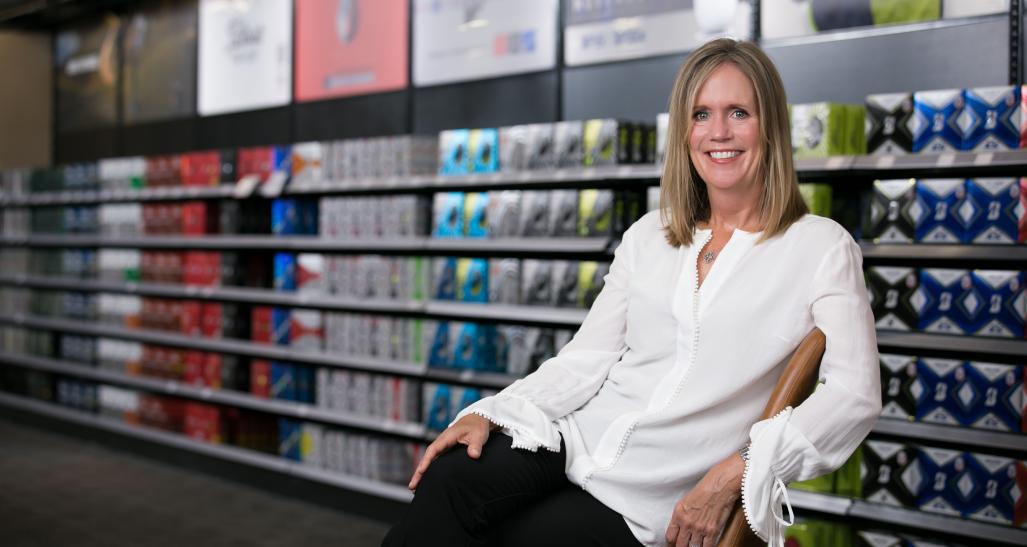
Something unexpected happened during the pandemic: Golf grew. Even more unexpectedly, a big bump in its growth with new golfers has been with women.
No one knows this better than Jill Spiegel, chief merchandising officer at PGA TOUR Superstore. The chain, which will have 50 sprawling retail locations nationwide by the end of 2021, is focused on growth — and most recently has laser-focused a chunk of its merchandising efforts on the estimated 500,000 women who took up golf over the past year. NRF spoke with Spiegel about the company’s efforts.
Learn about the other ways women are becoming more prevalent in retail.
Golf is widely perceived — or misperceived — to be a man’s sport. Why is that?
That’s the way it’s always been. It’s about 75 percent male and 25 percent female. Last year, 6 million new people came into the game — 3 million are beginners and about 3 million came back who had left. But the percentage of female golfers is growing. Last year, about a half-million beginning golfers were women.
What has led to this change?
Women themselves have helped to accelerate this change. Part of it is because more families are golfing together.
What is PGA TOUR Superstore doing to appeal to women?
For years, we’ve been focused on women more than the rest of the industry. We do a disproportionate amount of our women’s business in resort markets like Florida, Arizona and California, where people go to travel or retire.
How do you focus on women?
We want to make the stores inviting to them. With so many beginning golfers who are women, we want them to feel comfortable in our stores. We want to prepare them for what golf involves. We offer six hours of group instructions (six one-hour sessions) that introduce women to the game and prepare them for what to expect.
It’s not just about playing the game but also about learning the lingo. We help to educate them and make them feel more comfortable. We’re creating channels to make them feel welcome.
How do you merchandise to women?
When we open new stores, we lead with women’s apparel. We want that to be the first thing you see when you walk into the store, particularly in resort markets. The competition shoves women’s apparel to the back of the store. We try hard to make it visually clear to women that they are important to us.
How do you market to women?
Among other things, we’re an official retail partner of Women’s Golf Day, which is the first Tuesday of June every year. We launched our own “Girls Got Drive” campaign last spring to celebrate women and empower them to learn, have fun and excel at golf.
How have apparel makers changed in the way they approach female golfers?
In the old days, you’d have the men’s apparel designers also designing women’s golf apparel. They (mistakenly) assumed that what works for men will work for women. That’s not the case. Women don’t want the same thing that men want.
What else has changed in golf apparel?
Golf apparel isn’t just worn on the golf course anymore. There are more lifestyle products. So now we’re also seeing hoodies and joggers and women’s leggings that are not just for the course.
Do women purchase more golf apparel than men?
Women will often spend more on apparel because they want a complete outfit. They’ll not only purchase the top and skort, but also the layering piece. They want the sweater, too.
What about designer brands?
Sometimes we talk to designer brands for a year before we carry them. Some of our stores carry Tag Heuer watches.
What else has changed in golf equipment sales?
There’s been a big surge in pushcart sales. There’s now much more walking when golfing because more people are playing golf to stay healthy.
What have you done inside stores to make them look more appealing to women?
We’ve renovated most of the older stores. Every time we open a new store, we ask ourselves: Why didn’t we do this in the last store? The new stores have less clutter and less signage. They have more consistent fixtures and fewer vendor shops. We want consistency.
What differentiates PGA TOUR Superstore from the competition?
We offer a lot more brands in apparel and footwear. Our stores are big — up to 50,000 square feet. With more depth in merchandise, you have a better opportunity to find what you want in your size.
How do you personalize equipment sales?
Our stores have up to 10 simulators that measure your swing and your swing speed. We’re not afraid of helping a customer get more comfortable with the game of golf before they buy a new set of irons. It’s not about the sale, it’s about the relationship.
To some consumers, the name PGA TOUR Superstore might sound like the store is only for advanced golfers, no?
You couldn’t ask for a better name in golf. It’s like having the Good Housekeeping seal of approval. The minute you walk in the front door you can see how welcoming we are — especially with the repair shop typically in the front of the store.
What’s your best-selling product?
While we’re dominant in golf equipment, we also have a disproportionate share of apparel and footwear. Industry-wide during the pandemic, people were more concerned with great equipment and less concerned with what they wore. Now, the industry has had its biggest first half ever in apparel sales. That said, golf clubs will always be our biggest category.
What has surprised you?
We’ve seen a spike in tennis and pickleball sales.
What’s happened to your digital sales?
It really accelerated last year after stores closed during COVID-19. As we grow our national footprint, our digital sales continue to grow.
What are your growth plans?
When I arrived here 10 years ago, we had 11 stores. By the end of this year, we’ll have 50. So, we have more than quadrupled our store count in that time and our sales have grown 400 percent. Our store growth will be 15 percent to 20 percent annually.
How do you choose store locations?
We’ve only built a couple of stores from the ground up. About 90 percent of the time, it’s second-generation space. We took advantage of the Toys ‘R’ Us situation.
How did you rise to the top in a male-dominated profession?
I came in because they wanted someone with traditional retailing background. I was at Macy’s for years. People knew golf equipment but didn’t understand the rest. The softer side of the business is more margin-rich. It almost felt like a startup at the time.
How’s your golf game?
I played a lot of golf as a teenager. I still play now, but I’m not very good.


